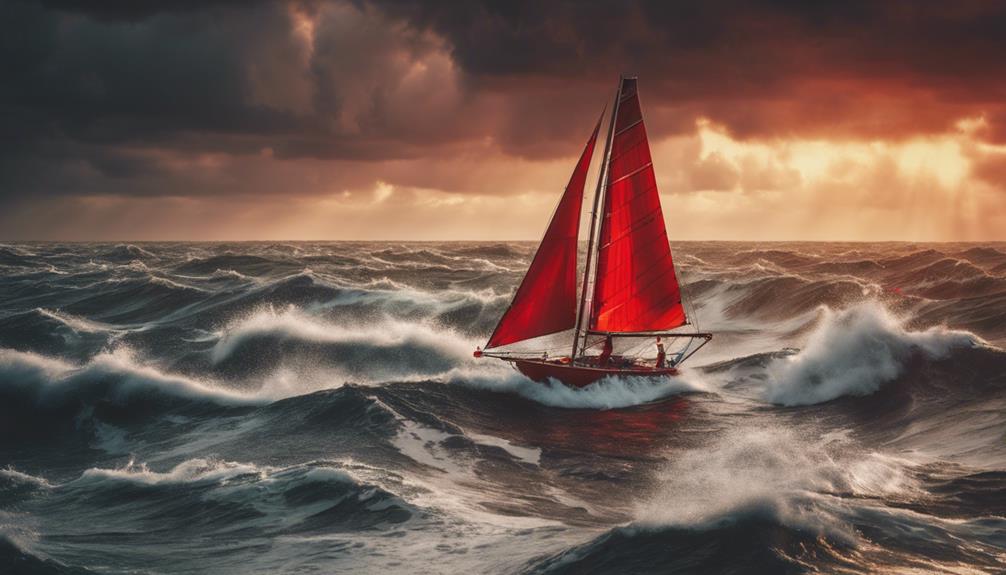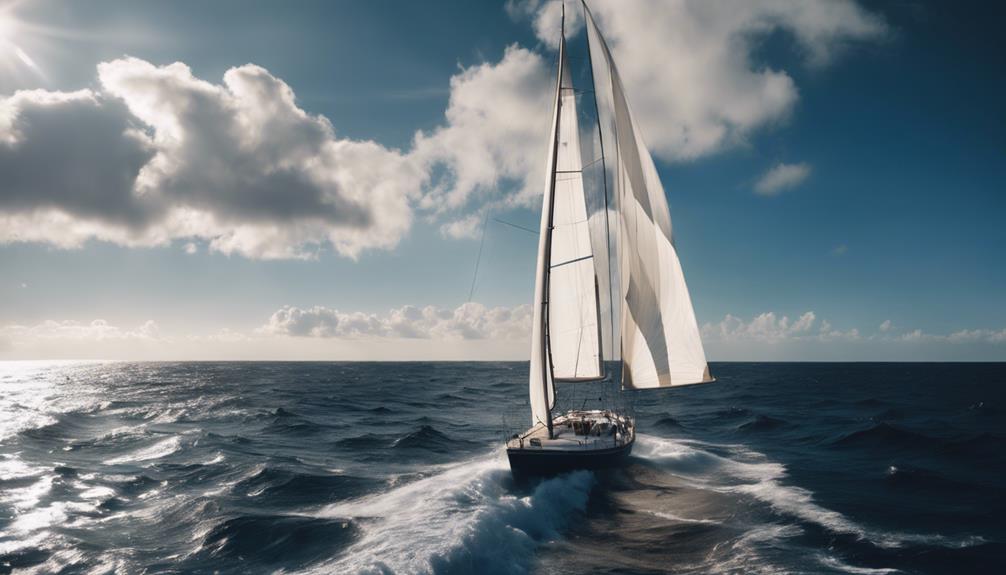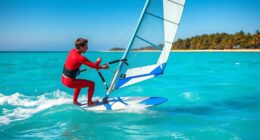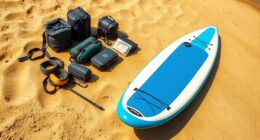If you're enthusiastic to learn about the fastest sailboat Atlantic crossing, you'll encounter amazing feats like Comanche's stunning record of 5 days, 14 hours, and 21 minutes. Sailing technology has dramatically evolved, allowing boats to reach unprecedented speeds. Records are consistently challenged, such as the incredible 3 days, 15 hours, and 25 minutes set by Banque Populaire V. Each crossing blends thrilling competition, strategic navigation, and skilled crews working together. These achievements reflect not only human determination but also innovation in design and materials. Keep on exploring to discover more about this exhilarating world of transatlantic racing!
Key Takeaways
- The fastest recorded transatlantic crossing was achieved by Banque Populaire V in 2009, completing the journey in 3 days, 15 hours, and 25 minutes.
- Comanche set a remarkable record for monohulls with a crossing time of 5 days, 14 hours, and 21 minutes, showcasing exceptional design and teamwork.
- Technological advancements, such as lightweight materials and innovative foils, have significantly enhanced the speed and performance of modern racing yachts.
- The competition in transatlantic racing is intensifying, with future contenders like Groupama 3 and Sails of Change aiming to break existing records.
Overview of Atlantic Crossing Routes
When planning an Atlantic crossing, you have several key routes to contemplate, each with its own unique challenges and advantages.
One of the fastest routes is from Ambrose Light, New York, to a line between Lizard Point, Cornwall, covering approximately 2,880 nautical miles. This route offers a blend of favorable winds and strategic sailing opportunities, making it ideal for those aiming for a transatlantic record.
On the other hand, if you choose the east-to-west crossing, known as the Route of Discovery, you'll traverse about 3,884 nautical miles from Cadiz to San Salvador Island. While this route is rich in historical importance, it's generally longer and may present different weather challenges.
For skippers looking to push for speed records, the west-to-east route is particularly appealing. The prevailing westerlies can greatly enhance your crossing speed, providing a strategic advantage.
However, remember that weather conditions and your sailing strategies will profoundly impact your success. Optimizing your route based on these factors can be vital when you're aiming for a personal or competitive speed record.
Record-Breaking Crewed Crossings
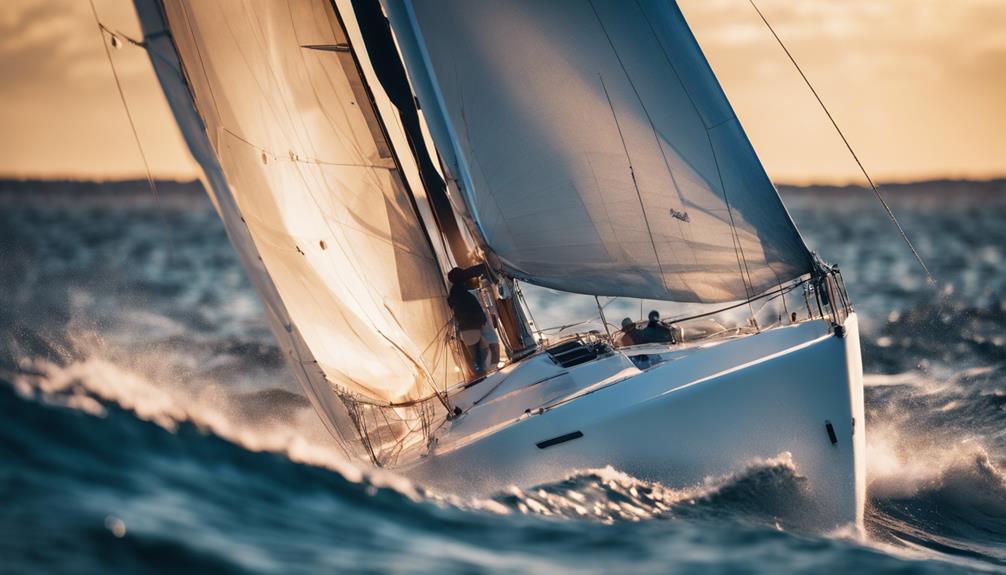
When you think about record-breaking crewed crossings, you'll notice some incredible times that have pushed the limits of speed.
Key skippers and their teams have harnessed advancements in technology to achieve these feats, transforming competitive sailing.
Let's explore the historic records and the innovations behind them.
Historic Record Times
Record-breaking crewed crossings of the Atlantic showcase the incredible speed and skill of modern sailing teams. These remarkable feats are defined by their astonishing record times, demonstrating how far technology and teamwork have come in sailing.
Here are some highlights:
- Banque Populaire V: Achieved the fastest transatlantic crossing in 2009, finishing in just 3 days, 15 hours, and 25 minutes, with an average speed of 32.94 knots.
- Groupama 3: Finished only 12 minutes later than Banque Populaire V, completing the journey in 3 days, 18 hours, and 12 minutes, averaging 31.92 knots.
These record times not only highlight the impressive speed achieved by these vessels but also reflect the dedication and expertise of the crews involved.
As new technologies emerge, we can only anticipate even faster crossings in the future.
Key Skippers Involved
The incredible achievements in transatlantic sailing wouldn't be possible without the skill and determination of key skippers who've pushed the boundaries of speed and performance over the years.
Each record attempt has showcased their relentless pursuit of excellence, leaving lasting legacies in the sailing community.
Charlie Barr set the foundation in 1905, completing the journey in just over 12 days. Fast-forward to 1980, and Éric Tabarly raised the bar considerably with a time of 10 days, 5 hours.
Then, in 1981, Marc Pajot broke that record, finishing in 9 days, 10 hours, and 6 minutes. Patrick Morvan took things even further in 1984, achieving a remarkable time of 8 days, 16 hours, and 36 minutes.
The pinnacle was reached in 1987 when Philippe Poupon completed the crossing in just 7 days, 12 hours, and 49 minutes.
These key skippers involved in record-breaking crewed crossings didn't just race against the clock; they inspired future generations of sailors to dream big and push their limits.
Their achievements remind us that the quest for speed is as thrilling as the ocean itself.
Technological Advancements Impact
Technological advancements have dramatically transformed the capabilities of sailing vessels, enabling crews to achieve extraordinary speeds across the Atlantic. These innovations haven't only broken speed records but have also redefined what's possible in competitive sailing.
Consider these key factors:
- Lightweight Materials: Modern boats are crafted from advanced materials, making them lighter and faster, as seen with Banque Populaire V averaging 32.94 knots in 2009.
- Aerodynamic Designs: Trimarans like Groupama 3 and Orange II utilize sleek designs, allowing Groupama 3 to average 31.92 knots during its record attempt.
Furthermore, enhanced navigation technology and weather modeling have empowered crews to fine-tune their routes. Comanche's record-breaking crossing exemplified this, utilizing ideal wind conditions and strategic planning.
In addition, the evolution of crew dynamics and training has fostered better collaboration, essential for achieving record speeds.
With these technological advancements, the future of Atlantic crossings looks brighter and faster than ever.
Comanche's Historic Achievements
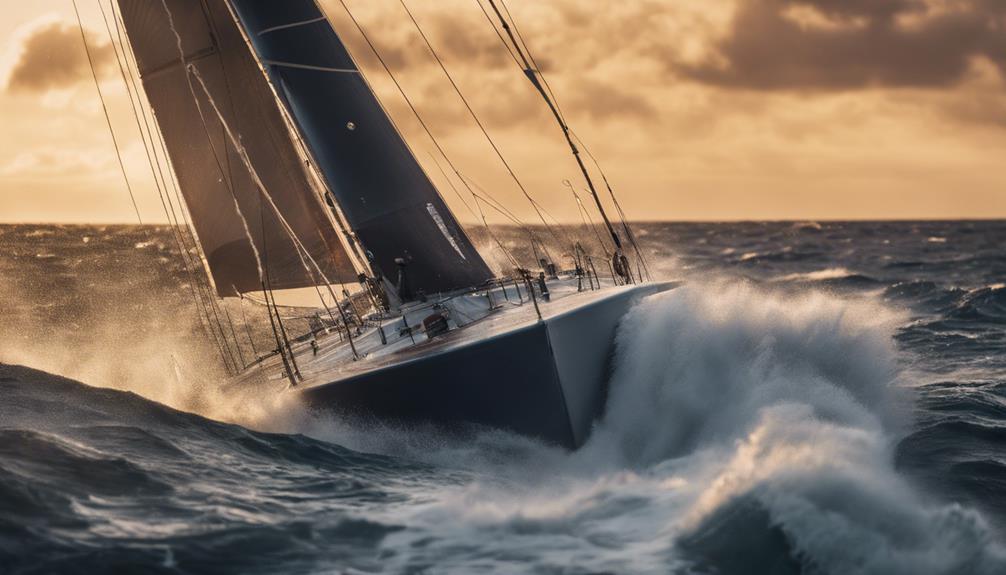
You can't discuss Comanche's historic achievements without highlighting its record-breaking Atlantic crossing in just over five days.
Then, there's the stunning 24-hour distance record, where it covered 618 nautical miles at an average speed of 25.75 knots.
Record-Breaking Atlantic Crossing
With a stunning time of just 5 days, 14 hours, 21 minutes, and 25 seconds, Comanche shattered the transatlantic speed record, showcasing the pinnacle of modern sailing prowess. This monumental achievement was led by skipper Ken Read, with crew member Casey Smith stepping up during media commitments, emphasizing the team's adaptability and resilience.
Comanche's record-breaking Atlantic crossing not only set a new standard but also highlighted the innovative design and technology that made it possible. Key factors that contributed to this historic voyage include:
- High-performance design: Comanche was specifically created for ocean racing, enhancing its speed and efficiency.
- Crew dynamics: The ability of the crew to adapt and work together seamlessly during challenging conditions played a vital role.
This remarkable crossing revitalized interest in transatlantic records and marked a notable milestone in the history of sailing. Comanche didn't just break a record; it redefined what's possible on the open ocean.
24-Hour Distance Record
Comanche set an incredible 24-hour distance record, covering 618.01 nautical miles and averaging a blistering speed of 25.75 knots during the 2015 Transatlantic Race. This achievement, accomplished under strong southwesterly winds in the North Atlantic, showcased the vessel's exceptional performance capabilities.
You can appreciate how remarkable it is for a monohull to challenge the traditional dominance of multihulls in long-distance ocean racing.
The World Sailing Speed Record Council ratified Comanche's record, affirming its significance in the sailing community. This recognition not only highlights the engineering excellence behind Comanche but also spotlights the crew's skill and strategy. They navigated ideal wind conditions masterfully, demonstrating how teamwork can elevate performance in competitive sailing.
As you reflect on this hour distance record, consider what it means for future competitions. Comanche's success redefines expectations and pushes boundaries, encouraging other vessels to aim for similar feats.
It's a confirmation of the potential of modern sailing technology and the relentless pursuit of excellence in the sport. With such a record, Comanche has firmly established itself as a formidable contender in the world of sailing, inspiring future generations of sailors.
Performance at St Barth
After a challenging performance in the 2014 Sydney Hobart race, Comanche rebounded spectacularly at Les Voiles de St Barth, setting a new record in the Maxi I class. The team, led by skipper Ken Read, showcased their exceptional sailing skills, completing the course in just 2 hours, 33 minutes, and 4 seconds. This remarkable achievement not only marked a significant turnaround but also solidified Comanche's status among elite global sailing yachts.
During the event, Comanche demonstrated its competitive edge by:
- Taking all line honors in the division
- Outperforming other high-caliber yachts
The performance at St Barth highlighted Comanche's high-performance capabilities, allowing the crew to fully capitalize on their strengths. Each member played a vital role, ensuring that the yacht maintained its speed and agility throughout the course.
The success at Les Voiles de St Barth wasn't just a win; it was a statement of resilience and skill, proving that Comanche could rise above setbacks and continue to set new records in the sailing world.
Sails of Change Record Attempt

How will the Sails of Change, manned by a skilled crew, fare in their ambitious attempt to break the trans-Atlantic sailing record?
Departing from New York at 13:10:08 UTC, the team is determined to outpace the current record of 3 days, 15 hours, and 25 minutes set by Banque Populaire V in 2009. With a crew of 11 experienced ocean racers, including skipper Yann Guichard and navigator Benjamin Schwartz, they've trained extensively for this record attempt.
The trimaran, measuring 37 meters long and 23 meters wide, boasts design features aimed at maximum speed and stability, essential for tackling challenging ocean conditions. They've timed their departure perfectly, coinciding with the record attempt period spanning from July to early November, ensuring they benefit from ideal weather patterns.
Forecasts predict favorable winds from the south and southwest, aligning with their sailing strategy.
As the Sails of Change sails towards its goal, the excitement builds. Will their preparation and favorable conditions lead to a historic achievement, or will the ocean prove to be an unpredictable opponent? Only time will tell.
Technological Innovations in Sailing
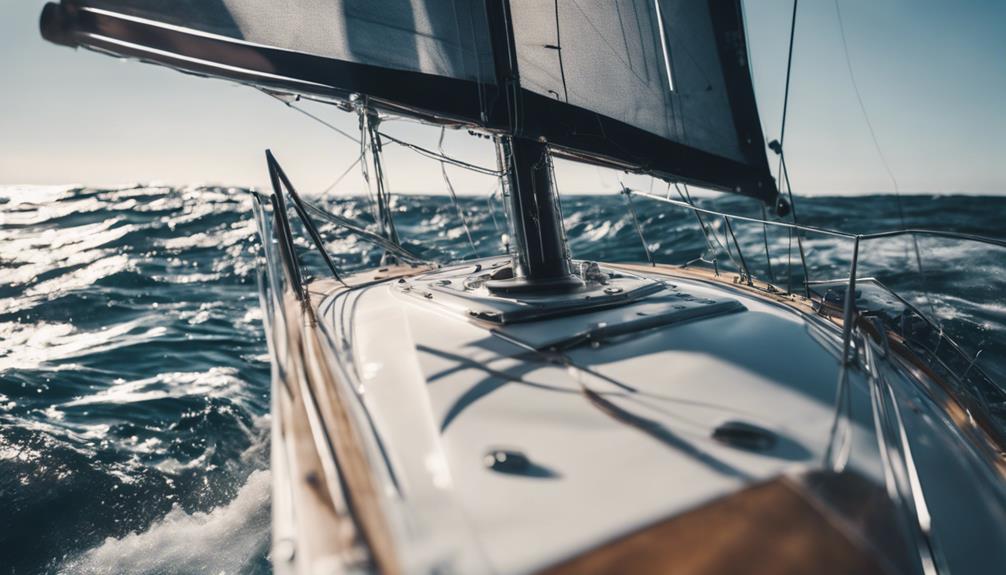
Technological innovations in sailing have transformed the sport, enabling vessels to achieve record speeds and enhanced performance like never before. One of the key advancements is the introduction of advanced foiling technology, such as the SailGP's T-Foils, which has allowed boats to reach astounding speeds, with Canada hitting 101.98 km/h (55 knots) during tests. These innovations not only boost average speed but also improve overall stability and control.
Here are some notable technological advancements in sailing:
- Hull Design and Materials: Modern vessels benefit from innovative hull shapes and lightweight materials, contributing to faster and more stable performances.
- Navigation and Weather Technology: State-of-the-art tools help skippers make informed decisions, essential for optimizing speed and safety during record attempts.
With these advancements, sailing has entered a new era, where achieving record speeds and breaking barriers isn't just a dream but a reality.
Future of Transatlantic Racing
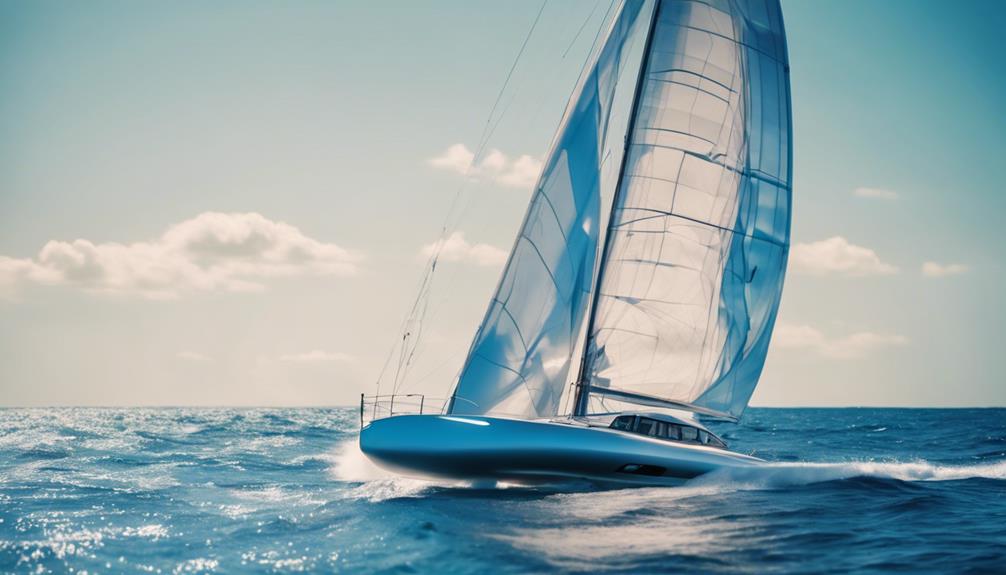
The future of transatlantic racing looks promising, with innovations in technology and strategy set to push the boundaries of speed and performance. You can expect future contenders to rise, like Groupama 3 and Sails of Change, enthusiastic to beat the current record held by Banque Populaire V, which stands at an impressive 3 days, 15 hours, and 25 minutes.
The upcoming Jules Verne Trophy will provide a prime platform for teams aiming to set new speed records through non-stop circumnavigation. As you follow these events, you'll notice the impact of cutting-edge sailing technology, such as foiling systems and lightweight materials, which are already transforming how races are run.
Moreover, the competitive landscape is becoming more dynamic with new entries, including INEOS Britannia in the Americas Cup, reflecting a growing interest in high-stakes ocean racing. This evolution signifies that the thrill of transatlantic racing is only set to intensify.
As more teams embrace innovation, you'll see exhilarating races that push the limits of what's possible. The ocean is ready for the next generation of record-breaking adventures!
Frequently Asked Questions
What Is the Fastest Transatlantic Boat Crossing?
The fastest transatlantic boat crossing was achieved by Banque Populaire V in 2009, completing the journey in just 3 days, 15 hours, and 25 minutes. You'd marvel at such incredible speed and precision!
What Is the World Record Sailboat Crossing the Atlantic Ocean?
The Atlantic's vast expanse becomes a racetrack, where Banque Populaire V holds the world record for the fastest sailboat crossing, completing the journey in just 3 days, 15 hours, and 25 minutes. That's pure speed!
What Ship Holds the Transatlantic Speed Record?
The ship that holds the Transatlantic speed record is Banque Populaire V. You'll find it completed the crossing in just 3 days, 15 hours, and 25 minutes, showcasing incredible speed and modern sailing technology.
What Is the Fastest Sailboat in History?
Imagine slicing through waves like a knife through butter—Banque Populaire V holds the title of the fastest sailboat in history, achieving an astonishing Atlantic crossing in just 3 days, 15 hours, and 25 minutes.
What Makes a Sailboat Fastest for Atlantic Crossing?
When it comes to setting the fastest sailboat recordbreaking journeys for Atlantic crossing, several factors come into play. The design of the sailboat, the materials used, the size and shape of the sails, and the skill of the crew all contribute to achieving record-breaking speeds. Attention to every detail is crucial.
Conclusion
As you dream of the open sea, remember the thrill of the chase, the allure of adventure, and the spirit of competition.
The fastest sailboats aren't just vessels; they're symbols of innovation, teamwork, and determination.
Whether you're inspired by Comanche's triumphs or the daring attempts of Sails of Change, the future of transatlantic racing promises excitement and evolution.
So, set your sights high, embrace the wind, and get ready for the next wave of record-breaking journeys.




